ISSA Proceedings 2014 ~ Changing The Practice Of Knowledge Creation Through Collaborative Argument Mapping On The Internet
No comments yet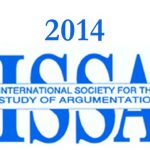 Abstract: Based on a definition of knowledge as “justified true belief,” this paper develops a vision of global, collaborative knowledge creation in a World of Arguments that is centrally stored on the Internet. Knowledge claims and hypotheses would be formulated, justified, and debated on continuously growing and improved argument maps. Additionally, the paper discusses a few problems of this vision.
Abstract: Based on a definition of knowledge as “justified true belief,” this paper develops a vision of global, collaborative knowledge creation in a World of Arguments that is centrally stored on the Internet. Knowledge claims and hypotheses would be formulated, justified, and debated on continuously growing and improved argument maps. Additionally, the paper discusses a few problems of this vision.
Keywords: AGORA-net, argument mapping, collaboration, computer-supported argument visualization (CSAV), individuality, Internet, knowledge, logosymphesis, scientific practice, visualization.
1. Introduction
The definition of knowledge as “justified true belief” – which seems to be widely shared in philo¬sophy since Plato introduced it in his dialog Theaetetus (201d) – requires that one can know only what one is able to justify. What we cannot justify, we might believe, but we do not “know” it. Only those statements can be claimed to be knowledge that can be justified by reasons. For this reason we can say that the process of justifying claims and hypotheses is at the core of knowledge creation. Providing reasons is the essence of scientific activity.
Based on this consideration, I will develop in this contribution a vision of how the practice of knowledge creation can be substantially changed by using collaborative argument visualization software that allows synchronous and asynchronous collaboration on graphically represented “argument maps” on the Internet. Starting from a description of traditional knowledge production as a four-step process of research, publication, debate, and new research, I will show in the first part that computer-supported collaborative argument visualization – CSCAV, as I call it – can change the practice of knowledge creation in a variety of ways, most importantly by putting collaboration in the centre of scientific activity, so much even, that the contribution of individual scientists and scholars might disappear behind the communal effort.
In the second part, I will discuss some problems of such a shift to CSCAV-based knowledge production: How can large-scale argument mapping be integrated with the rhetorical demands of communicating knowledge? What happens if the very idea of “publication” becomes obsolete because in collaborative argument mapping there is no point in time when the process of reasoning, deliberating, communicating, and fighting about a position comes to a stop? Will the concept of “authorship” lose its significance when the focus of knowledge production is on representations of knowledge that grow without limits in space and time in form of growing argument maps? And then there are more technical questions such as: How can it be possible to revise the overall structure of huge argument maps and their main conclusion, especially if there are conflicts on how to frame a knowledge area? How to keep the right balance in collaborative systems between openness and security when it comes, for example, to dealing with trolls and other destructive behaviour?
2. From “publishing” to “logo¬symphesis”
We are all familiar with what can be described roughly as a four-step process of research, publication, debate, and new research. First, we do research and develop arguments in texts. Then we publish these texts in the form of journal articles, chapters, books, or conference presentations. In a third step, we debate publications – ours and those of others – and, finally completing the circle, we engage in new research. This recursive process is characterized by a clear separation between individual and social activities. Papers and books are written by individuals or, usually, small groups of authors, while social exchange happens in peer review, at conferences, in seminars, and in person-to-person communication.
Given the tremendous changes that newly developed software tools and the Internet brought to almost all areas of life over the past decades, an important question for the future of science is what the possibilities of the Internet will, could, and should mean for the creation of knowledge. There is already – particularly in computer science and fields close to it – a large amount of literature that discusses this question. For example, in Knowledge Cartography, Alexandra Okada, Simon Buckingham Shum, and Tony Sherborne asked contributors to describe visualization tools they developed, ranging from “mind mapping” and “concept mapping” to argument, evidence, issue, web, and thinking mapping (Okada et al., 2008). Katy Börner provided an even broader picture in her Atlas of Science: Visualizing What We Know (Börner, 2010). In addition to an impressive collection of visualizations that focus, in particular, on information and data, Börner locates her work on “science maps” in a history of visionary approaches to knowledge collection, encyclopaedias, knowledge dissemination, knowledge classi¬fication, knowledge interlinkage, knowledge visualization, man-machine symbiosis, and the “global brain” (pp. 14-25).
Compared to this broad range of activities, the following considerations focus on a very small and specific area. Based on the philosophical definition of knowledge as “justified true belief,” I limit the term “knowledge creation” here exclusively to the following four, connected activities:
1. formulating knowledge claims and hypotheses;
2. providing reasons and evidence for them;
3. debating claims and their justifications; and
4. continuously improving these claims and justifications.
With this very narrow focus in mind, we can point at three types of examples in which the Internet played already a major role for the creation of knowledge. First, there is web-based debate about published work. For example, there was in the beginning of this year a lively online debate about a pair of articles published by Harukos Obokata and her team in Nature that describe a new method to create pluri-potent cells out of ordinary non-stem cells (Economist, 2014a). Since research with stem cells requires the use of aborted foetuses, there is a great deal of interest in methods that allow the same kind of research with cells taken from adults. So, the astonishing results led quickly to attempts to replicate them, but without success. This failure was reported immediately online, which again led to extensive discussions on blogs and websites about irregularities in diagrams and pictures of the two articles. On July 2nd, only five months after publication, Nature formally retracted the two papers (Economist, 2014b).
A second type of example for the role of the Internet for knowledge creation is a process called “open peer review.” Fritz and Gloning (2012) define it as a process “in which anyone can appoint herself a peer and criticize work that has entered the public domain.” In open peer review, the secrecy of traditional peer review and the unaccountability of reviewers is overcome, but the process is obviously less controllable.
A third type are blog discussions on articles submitted to open peer review. This refers to a mixture of the two first types of examples (Fritz and Gloning, 2012). As Fritz and Gloning discuss, these three types of activities that contribute to knowledge creation of the web have the potential to change important aspects of scientific communication:
* They substantially enlarge the reach of scientific information, but they may also “attract unqualified and disruptive participants” (pp. 229-230).
* They increase the “speed of publication,” but it is also noteworthy that “rash replies increase the risk of injury” (p. 229).
* They increase the amount of interactivity between scholars.
* They provide transparency for the general public about important scientific controversies.
It should be noted, however, that these three types of contributions to web-based knowledge creation still remain within the boundaries of the traditional four-step-process of research, publication, debate, and new research. Web-based debate about published work is still a form of debate, only faster and with a wider reach. Open peer review of journal submissions still remains within the idea of traditional publishing, and blog discussions that might branch off of reviews on articles submitted to open peer review simply combine debate and publication.
The question, thus, is: Does the Internet provide possibilities that substantially change the usual four-step-process? Based on the crucial role that justifications play for the creation of knowledge, I can imagine a world in which central areas of knowledge production – formulating claims and hypothesis, providing reasons and evidence for them, debating claims and their justifications, and continuously improving claims and justifications – are done online in the form of collaboration on centrally stored “argument maps.”
An argument map is, as Tim van Gelder – one of the pioneers of “argument mapping” – writes in an encyclopaedia entry on the topic, “a ‘box and arrow’ diagram with boxes corresponding to propositions and arrows corresponding to relationships such as evidential support” (van Gelder, 2013). Such a graphical representation of arguments has the advantage, compared to representing arguments either in texts or in numbered lists of propositions, that the structure of more complex argumentations – in which, for example, reasons might be justified by further arguments, and so on – is more easily to comprehend. Working step by step from one area of a two-dimensional map to the next should reduce the cognitive load that is required, in each moment, to analyse and understand arguments (Hoffmann, 2013).
The vision that I have in mind includes the following. There might be one place on the web where a “World of Arguments” can be found. This world might be accessible through a variety of portals (for example for different languages or different groups of people such as professionals on one hand and different educational levels on the other, or lawyers v. journalists or companies, etc.). Arguments might either be organized in fixed knowledge fields, be it disciplines, sub-disciplines, and subject areas, or problem areas in which multiple disciplines collaborate, or they might be organized dynamically, dependent on user interests and abilities to manage the system. The lowest level of any organization consists of claims and theses. Everybody, from all over the globe, can click on such a claim and an argument map opens that provides a justification for this claim in form of an argument map. The argument map is the place where collaboration happens. Users can add arguments to existing assumptions that might be questionable, they can add objections to specific assumptions and justify them by arguments, and they might be able to add comments, definitions, questions, references, friendly amendments to improve existing formulations, and links to both other arguments and to other resources on the web, if reasons are justified by experimental data and so on. Of course, everybody can also create new arguments either for other claims, opposing claims, or only slightly different claims. Additionally, it should be possible to copy existing maps to modify them and to copy strings of justifications from one map into another. Collaboration on arguments should be both synchronous – meaning that users can change things at the same time – and asynchronous so that things can be changed and added at any time.
There are already CSCAV tools available online that provide most or some of the functionality that is required to realize this vision, even though in very different ways (see Table 1). Since I developed myself AGORA-net, and since the AGORA software realizes already most of the functionality listed above, I will use it in the following as an example for my vision of collaborative knowledge creation. Computer-supported collaborative argument visualization (CSCAV) that allows the graphical presentation of arguments and collaboration on argument maps on the Internet has the potential to fundamentally change the practice of creating knowledge in a variety of ways.

Table 1: Some currently available CSCAV tools, alphabetically ordered. Only tools are listed that are both collaborative and allow two-dimensional representations. These tools are designed for very different purposes, from education to public deliberation, corporate decision making, and legal argumentation. * indicates commercial products
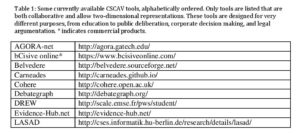 1. By focusing exclusively on the structure of arguments and argumentations (that is: on inferential relations), CSCAV minimizes distractions and the marginalization of certain perspectives that might occur when discussions can be dominated by non-argumentative means such as rhetorical tricks or simply repeating the same ideas time and again, as it often happens in blogs.
1. By focusing exclusively on the structure of arguments and argumentations (that is: on inferential relations), CSCAV minimizes distractions and the marginalization of certain perspectives that might occur when discussions can be dominated by non-argumentative means such as rhetorical tricks or simply repeating the same ideas time and again, as it often happens in blogs.
2. By allowing and fostering collaboration through the entire process of knowledge production on a large scale, individual and social aspects of knowledge production are more closely intertwined in CSCAV as it is traditionally the case.
3. A centrally located “World of Arguments” would provide one place where all knowledge of the world could be found and everything is accessible for everyone in one large structure of world knowledge; one place where all disagreements are debated, and all possible perspectives on things have a place to be developed, justified, and criticized. The latter means that every claim can be framed by whatever conceptual, theoretical, or ideological means a user brings to a knowl¬edge area. One central location does not mean that there would be centralized control. As any representational system, such a World of Arguments would have representational constraints (one can only represent those entities that are provided by the software), but the content that users create should not be controlled by anyone; diversity needs to be guaranteed to secure innovation and development.
4. By creating all knowledge within an already existing structure, there is no need – as we do it currently in publications – to contextualize our contribution by describing a problem and providing a review of the literature. The accepted knowledge from which we start – the “shoulders on which we stand” – is already given in arguments that are already in the system. As knowledge creators, we work at different “construction zones” of argument maps, or we create new ones.
5. And we are always working with others. We add to, or criticize, the arguments of others and others add to, and criticize, our arguments. At the core of such a World of Arguments is collaboration, be it realized in the form of mutual support or adversarial criticism.
The fact that collaboration is so deeply ingrained in what I envision as computer-supported collaborative argument visualization in a World of Arguments will lead, I assume, to a fundamental shift in how we perceive our individuality as scientists and scholars in contrast to the knowledge we produce. Currently, our individuality is documented in the things we publish: journal articles, books, book chapters, blogs, and so on. However, shifting all this to what could be perceived as mere “contributions” to an already existing World of Arguments could imply for many the experience that their individuality will take a back seat in favour of the growing World of Arguments itself. In an article in which I discussed some of these ideas for the first time, I coined the term “logosymphesis” to describe what is going on (Hoffmann, 2013; more precisely, I called it “syn¬ergetic logosymphesis”). “Symphyestai” is Greek and means “growing together into a unity.” “Logo-symphysis” is intended to refer to the growth of argumentative structures. More precisely, I define logosymphysis as a process in which an argumentative structure (composed of arguments, counterarguments, counter-counterarguments, and so on) grows continuously in a collaborative effort. In CSCAV this argumentative structure is an argument map that is stored online.
Logosymphesis in an Internet-based World of Arguments realizes an idea that Charles S. Peirce, the founder of American pragmatism and semiotics, envisioned about a hundred years ago when he wrote about the “growth of reasonableness” and the “development of Reason.” For Peirce, individual acts of reasoning are, at the same time, governed by the “development of Reason” (because all reasoning uses signs and representations that are socially shared and develop over time) and they constitute this process. Peirce conceives “this very development of Reason” as the “creation of the universe,” a process that is “still going on today and never will be done.” Individuals like us are just “giving a hand toward rendering the world more reasonable whenever, as the slang is, it is ‘up to us’ to do so” (Peirce, EP II 255; and Peirce, CP 1.615, 1903).
3. Problems
In order to get a clearer picture of what I suggest here as collaborative argument mapping on the Internet, CSCAV, or logosymphesis in a World of Arguments, it should be bene¬ficial to discuss some of the problems that come immediately to mind. I would like to start this discussion with a few argument maps or, more precisely, with some excerpts from those maps since the size of infinitively growing argument maps excludes them, obviously, from traditional modes of publication. These maps are produced in AGORA-net. They are accessible online at http://agora.gatech.edu/release/English.html. To just to see them in their entirety, “Enter as Guest,” but if you like to engage in collaborative argument mapping, you have to register. The easiest way to find these maps in a database of currently almost 10,000 argument maps (most of them are not publicly accessible, though) is to search for their map ID.
The first argument map (#9771) justifies the thesis “collaborative argument mapping (logosymphysis) is better than individual argument mapping.” Figure 1 shows the entire map. You will not be able to read anything, but this picture shows the overall structure. The blue parts represent the original argument whereas the orange parts represent an objection to a specific assumption of the original argument, together with its justification (also in orange). As you will see also in Figure 2, the main conclusion of this argument is located in the top-left corner of a two-dimensional space that can expand infinitively (as far as I can tell) to the right and downwards. This conclusion is defended by three independent arguments that are located from top downwards on the left side. (Since AGORA-net creates only logically valid arguments, every argument has always three types of components: one conclusion, one “enabler,” that is the premise located underneath the “therefore” in Figure 2, and an arbitrary number of reasons.) The reason of the first argument in the top-left corner is defended by two further independent arguments, and so on.
Figure 2 shows the first main argument, the one that is located in the top-left corner of Figure 1. This argument is provided here only to illustrate the structure of one complete argument. More import for the purpose of this discussion is Figure 3. Based on the limits of reproduction, the conclusion of this argument is cut off. But as you can see in Figure 1, the line of the left side of Figure 3 is going up to the main conclusion as it is represented in Figure 2.
I want to show two different things with this example. On the one hand, I would like to focus on the content of this argumentation and the controversial question what role assigning individual merit plays for the growth of knowledge. The objection of “GeorgePBurdell” (in this case a fictional character) should be perfectly reasonable. This means that the relation between individuality and logosymphysis that I discussed at the end of the previous section is a real problem for creating knowledge through collaborative argument mapping.
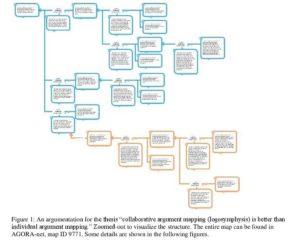
Figure 1: An argumentation for the thesis “collaborative argument mapping (logosymphysis) is better than individual argument mapping.” Zoomed-out to visualize the structure. The entire map can be found in AGORA-net, map ID 9771. Some details are shown in the following figures.
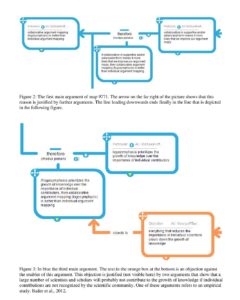
Figure 2: The first main argument of map 9771. The arrow on the far right of the picture shows that this reason is justified by further arguments. The line leading downwards ends finally in the line that is depicted in the following figure. Figure 3: In blue the third main argument. The text in the orange box at the bottom is an objection against the enabler of this argument. This objection is justified (not visible here) by two arguments that show that a large number of scientists and scholars will probably not contribute to the growth of knowledge if individual contributions are not recognized by the scientific community. One of these arguments refers to an empirical study: Bader et al., 2012.
On the other hand, I would like to use this example to illustrate how the process of collaborative knowledge creation through argument visualization could go from here. Since I, as the author of the original argument, accept the objection provided by Burdell, I would like to reformulate my argument. Since it is impossible, in AGORA-net, simply to delete or change what other users wrote (it shouldn’t be too easy to get rid of strong criticism),[i] I have to copy the entire argumentation. This way I gain ownership of all components of the map, including the ones provided by Burdell, and I can change whatever I want. To make clear, though, that I am using material provided by other people in a copy, every text box that is taken from the original map includes behind the author name a small, red button “PA,” meaning “previous author.” If I move the mouse over it, the name of the original author pops up. At the same time, every viewer of the new map can click on “history” on the right panel that is visible on each argument map to get access to the original map.
Now, going back to the content of this argumentation, I would think that the original argument should be improved by changing the overall conclusion, and by justifying this change by adding a reason that is directly taken from Burdell’s objection. What I have in mind as a better argument is depicted in Figure 4.
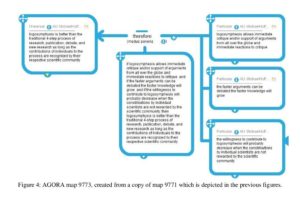
Figure 4: AGORA map 9773, created from a copy of map 9771 which is depicted in the previous figures.
The main change of the conclusion is that it is now formulated as a conditional statement. The addition of the condition is justified by the third reason on the right, which goes back directly to Burdell’s objection. It should be noted that the decision, in designing AGORA-net, to show the user name of the person who creates a text box within this text box, was motivated by the kind of considerations that are discussed in these maps. In collaborative argument mapping it should be clear who contributed what. However, it still remains a serious question whether this is enough to cope with the concern that scholars and scientists would engage in collaborative argument mapping as a new form of knowledge production only if their engagement is honoured by their respective scientific community, for example when it comes to promotion and tenure.
Another problem of collaborative argument mapping that becomes visible in this example relates to the more technical – or procedural – question of how to deal with revisions of argumentations that affect their overall structure. Every author of a text box can change the formulation of its text at any time, so I could have inserted the main conclusion of Figure 4 also in the main conclusion of Figure 2. But often such a change requires changes also in the formulations of the reasons and/or their overall structure. As in Figure 4, I can always add reasons to an existing argument, but I could not delete my own reason that is depicted in Figure 3 since an objection by somebody else is attached to it (again, that would make it too easy to get rid of critique). As I said, the only thing I can do is to copy the map and change everything as I need it.
The problem is that this could lead – in collaborations with large numbers of users – to an enormous variety of maps on the same topic. That would not only be very confusing, but it would also cost a lot of effort and time for everybody to study the differences, and then to decide where to contribute. It would be better if collaborators could deliberate what to do, on which maps they should focus, and which ones should be deleted. AGORA-net provides a rudimentary infrastructure for such deliberation. (A chat function and the possibility to add to each text box friendly amendments and comments, and the possibility to add further comments and other things to existing comments and other things. – If the small triangle at the bottom of a text box is yellow instead of white, as visible in Figures 2-4, that indicates that there are those additions that can be seen when one clicks on this triangle.) But this deliberation infrastructure in itself will not be sufficient to cope with the complexity of such deliberations.
Further problems that should be discussed refer to rhetorical necessities to communicate knowledge; the idea of “publishing” that goes through the window if there is simply no point in time when a growing argument map can be declared “completed”; and the question of how to balance the openness of online collaboration with security issues.
With regard to the first point, the question of how to deal with rhetorical demands of communicating knowledge, it is hard to say how serious that is. It is clear that in the process of creating knowledge in the form of large-scale argument maps, scientists would focus exclusively on the inferential structure of knowledge and evidential relations. But if this is indeed the core of scientific knowledge, then there should be no harm in delegating everything else to modes of communication that exist outside a World of Arguments. In educational settings, a teacher or instructor will still use all sorts of rhetorical means, such as storytelling, problem descriptions, and contextualization, that are helpful to introduce the novice to knowledge and the process of knowledge production. And anybody else is free to do the same.
Questionable, I think is also whether there is much harm in giving up traditional publications. Journal articles, books, blogs, and material provided on web-pages do not have a value in themselves. Historically, they were developed to facilitate scientific exchange and debate. Today, they are additionally important to assess the “value” and “impact” of individual scientists. But if all these functions can be achieved by other means – and at least for the representation, creation, debate, and ongoing improvement of knowledge that seems to be the case – then the question should be: what is the best way to do things? At this point, we should note that traditional publications have many disadvantages: they are always isolated entities that are connected to their respective contexts only by means of references; they do not allow any collaboration with people outside of the group of authors; and they might insinuate an idea of completeness that is not appropriate – whatever appears to be perfectly justified in a publication can be criticized from alternative or opposing points of view. In a growing argument map, by contrast, everything can be accepted as justified as long as there is at least one independent argument whose premises are not defeated or questioned.
More serious, I think, is only the question of how to find the right balance in collaborative systems between openness and security when it comes, for example, to dealing with trolls and other destructive behaviour. Bad arguments can be criticized or ignored – for example by allowing voting on the quality of argumentations – but destructive or disruptive behaviour as it has been observed in many areas of online activities, from gaming to blog discussions, can be so annoying that the entire project of collaborative knowledge production on the Internet could be endangered. From a technical point of view, it would not be a problem to erase all contributions of a certain user from a database, but the question is who decides on such a drastic step based on which criteria. Any serious knowledge infrastructure will need a governance structure that would develop policies and mechanisms for decision making and for enforcement. However, since everybody whose user account has been eliminated this way can create a new account at any time, it might be necessary to develop knowledge systems so that personal identities can be checked. This, however, raises again serious privacy and data security issues.
4. Conclusion
In this paper I showed that collaborative argument mapping on the Internet can sub¬stantially change the practice of knowledge creation, and I discussed some of the problems that would arise from such a change. Like everything else that happens on the web, logosymphesis – a process in which argumentative structures grow continuously in a collaborative effort – can overcome limits of space, time, and access, and would, thus, contribute to the empowerment of users from all over the world. More importantly for scientific purposes, it can enormously increase the level of collaboration so that indivi¬dual and social aspects of knowledge production are more closely intertwined than in traditional scientific activity. Moreover, everything we know in a specific area could be found at one place. If all knowledge would be formulated, justified, debated, and improved in one World of Arguments, there would be no need for a literature search, everything would already be there. While the potential of computer-supported collaborative argument visualization (CSCAV) for knowledge creation should be clear, the problems of such a change – a decrease of the importance of individual contributors in favour of the growing knowledge structure in itself; a decreasing role of traditional publications; and problems of governing online interaction among others – seem to require, on the one hand, the further development of available CSCAV tools and, on the other, certain changes in well-established institutional structures, for example with regard to the assessment of scientists and their impact. But even if it turns out that my vision of changing the practice of knowledge creation through collaborative argument mapping on the Internet goes too far, available tools can still be useful for things like the organization of large-scale meta-reviews that summarize research in the form of growing argument maps.
Acknowledgements
This research and the development of the AGORA software has been supported by a grant from the U.S. Department of Education (FIPSE Grant P116S100006). I thank the audience at ISSA 2014 for helpful feedback and suggestions.
NOTE
i. At least on published maps. In “projects” (accessible only for those users that the creator of the project added as “members”) it is possible to switch between an “adversarial” und “collaborative mode.” In the latter, every member can change everything
References
Bader, A., Fritz, G., & Gloning, T. (2012). Digitale Wissenschaftskommunikation 2010-2011. Eine Online-Befragung. Unter Mitarbeit von Jurgita Baranauskaite, Kerstin Engel und Sarah Rögl. Gießen: Gießener Elektronische Bibliothek.
Börner, K. (2010). Atlas of science: visualizing what we know. Cambridge, Mass.: MIT Press.
Economist (2014a). Peer review: Acid test. Doubts over ground-breaking stem-cell research are just what the field needs. Economist, March 22nd.
Economist (2014b). Regenerative medicine: Bad science. Economist, July 10th.
Fritz, G., & Gloning, T. (2012). Critique and controversy in digital scientific communication. New formats and their affordances. In F. H. v. Eemeren, & B. Garssen (Eds.), Exploring Argumentative Contexts (pp. 213–232). Amsterdam ; Philadelphia: John Benjamins Pub. Co.
Hoffmann, M. H. G. (2013). Changing philosophy through technology: complexity and computer-supported collaborative argument mapping. Philosophy & Technology (pre-print version available at http://works.bepress.com/michael_hoffmann/41/), online first. doi:10.1007/s13347-013-0143-6
Okada, A., Buckingham Shum, S., & Sherborne, T. (Eds.). (2008). Knowledge cartography. London: Springer.
Peirce (CP). Collected papers of Charles Sanders Peirce (Volumes I-VI, ed. by Charles Hartshorne and Paul Weiss, 1931–1935, Volumes VII-VIII, ed. by Arthur W. Burks, 1958; quotations according to volume and paragraph). Cambridge, Mass.: Harvard UP.
Peirce (EP). The essential Peirce. Selected philosophical writings. Vol. 1 (1867–1893), Vol. 2 (1893–1913) (ed. by Nathan Houser and Christian Kloesel, Peirce Edition Project). Bloomington and Indianapolis 1992 +1998: Indiana University Press.
van Gelder, T. (2013). Argument Mapping. In H. Pashler (Ed.), Encyclopedia of the Mind (Vol. I, pp. 51-53). Thousand Oaks, CA: Sage.
You May Also Like
Comments
Leave a Reply





